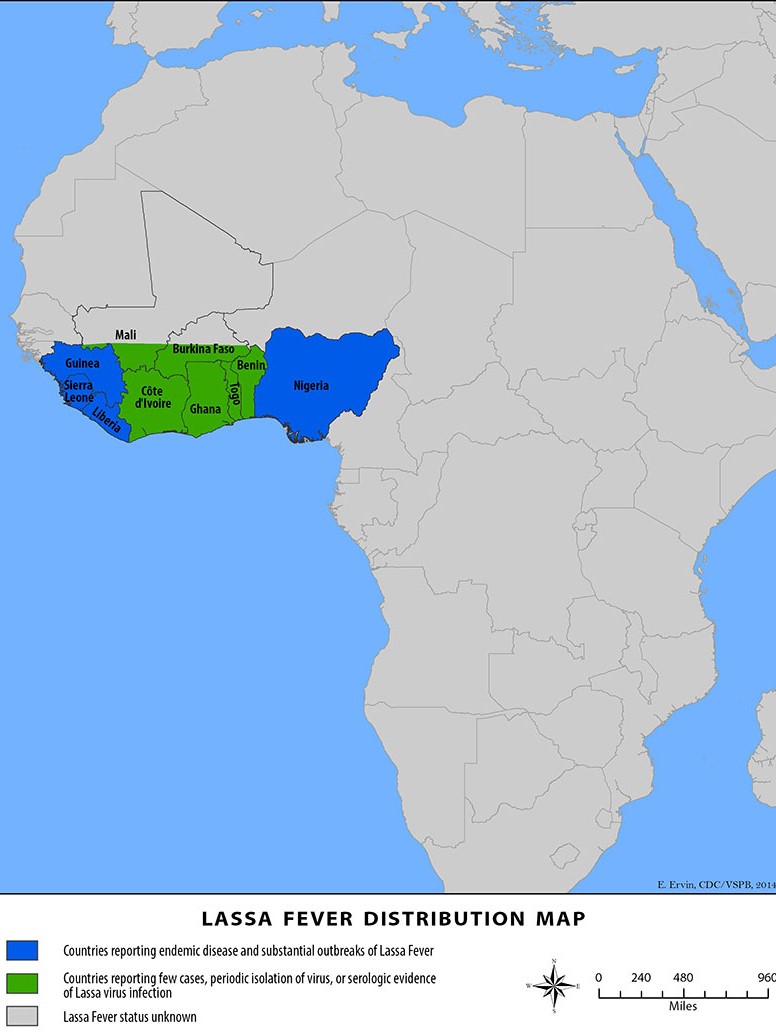Lassa Fever
Outbreaks
Updated 10/28/24
Note: Lassa fever is endemic in West Africa, and cyclical outbreaks are expected in that region.
October 28, 2024: The Iowa Department of Health and Human Services (HHS) confirmed the death of a middle-aged eastern Iowa resident from Lassa fever. It was reported that this individual, who is a resident of eastern Iowa, had recently returned from travel to West Africa. Further investigation into this case is underway by public health authorities (Iowa HHS, accessed 10/28/24, https://hhs.iowa.gov/news-release/2024-10-28/state-and-hospital-officials-follow-federal-guidance-after-lassa-fever-death).
About Lassa Fever
Lassa fever is a zoonotic disease spread by the Mastomys rat, found throughout sub-Saharan Africa. Lassa fever is a viral hemorrhagic fever in the Arenavirus family. Lassa fever is endemic to the rodent population in West Africa and is only known to be spread zoonotically by the Mastomys rat. Lassa fever is transmitted primarily by exposure to an infected Mastomys rat, which is both a reservoir and a vector for the virus. Human infection occurs through contact with infected rats and their feces, urine, or saliva directly or via surfaces. Human-human transmission can occur, although less common, and is spread through exposure to infectious body fluids in healthcare or household settings.
The incubation period for Lassa fever is between 2-21 days. Lassa fever can result in a severe viral infection, including death. However, the majority of individuals infected with Lassa fever have no symptoms (80%). The onset of symptoms is gradual, with fever, weakness, and malaise. After a few days, illness can progress to headache, sore throat, muscle, chest, and abdominal pain, nausea, vomiting, diarrhea, and cough. In cases with severe disease, facial swelling, fluid in the lung, bleeding from the mouth, nose, vagina, and gastrointestinal tract, and low blood pressure can occur. Other clinical signs include blood in the urine, shocks, seizures, tremors, disorientation, and coma in later stages of the disease.
The Lassa fever virus can cause severe illness with a mortality rate of 1%. However, the disease in mothers and fetuses is as high as 80% when illness occurs in the third trimester. In patients who recover, deafness, hair loss, and walking changes can occur.

Figure: CDC Outbreak Lassa Distribution Map.
Where to Start
- See the CDC's Lassa Fever Factsheet.
- See the WHO's Disease Outbreak News (DONs) for the latest updates on recent outbreaks of Lassa Fever.
Selected Resources
NETEC has curated essential Lassa fever resources. If you have questions or need support, you can submit a request via the website or by emailing info@netec.org, and one of NETEC’s experts in special pathogens will respond.
Featured Resources
Treatment & Care
Personal Protective Equipment (PPE)
Waste Management and Cleaning & Disinfection
Laboratory
Additional Resources
Training Resources
Guidance Resources
Research Resources
Page Reviewed: 10/29/2024

































